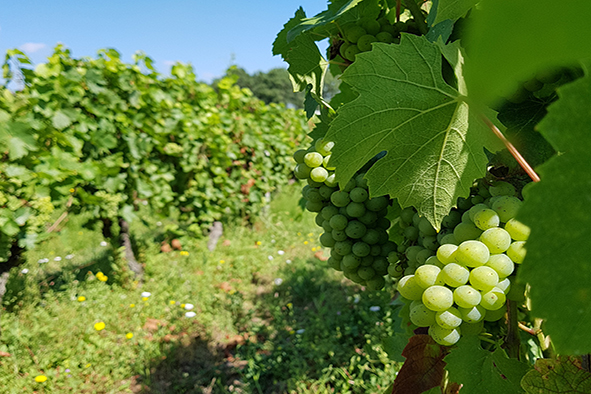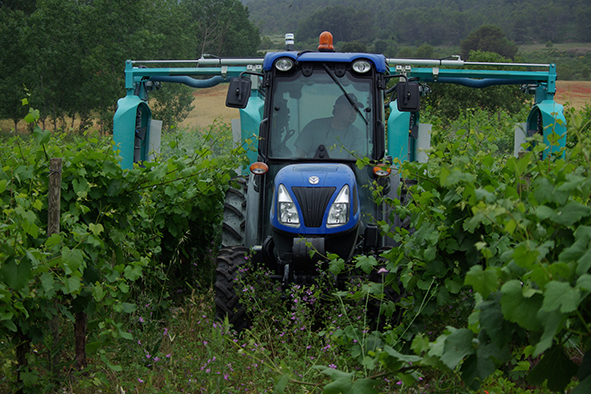Measurement of the quantities of spray deposits obtained on the EvaSprayViti test bench clearly show that high-performance spraying techniques exist which represent significant progress compared to the most commonly used techniques.
A demonstration in 3 questions and answers.
Question / Answer n°1
Should the characteristics of the vegetation being sprayed be taken into account to optimize the use of phytosanitary inputs?
Since the phytosanitary protection season begins when the plant is just starting its growth cycle and ends when the vegetation is at maximum development, it is surprising that the same dose of product, defined per hectare and therefore constant throughout the season, should be used to protect such varied quantities of vegetation. To study the influence of the growth stage on the amount of spray deposits, sprayer performance was assessed at the three stages in growth development that can be simulated by artificial vines. The 17 sprayers for vineyards with wide rows (inter-row equipment) were evaluated for artificial vegetation with row spacing of 2.5 metres and a foliar index of 0.24 (m2 of leaf per m2 of soil) at the beginning of growth, 0.88 in the middle and 1.68 at full growth.
These measurements showed that the quantity of spray deposits depends to a great extent on the nature of the vegetation being sprayed. On average, for the sample population of machines studied, spray deposits per unit area of foliage varied by a ratio of 1 to 4 between full growth and early growth. These results make it possible to affirm that the use of the approved dose of phytosanitary product, expressed per hectare of cadastral surface area, which is constant throughout the spraying season, results in an actual dose, which has a genuine impact on protection and is expressed in terms of units of plant surface area, that varies by an extremely significant ratio. Moreover, the doses of plant protection product (PPP) are expressed according to vegetation growth in Germany and Switzerland, for products identical to those used in France.
Consequently, the greatest scope for reducing the quantities of PPPs used would seem to lie in treatments at the beginning of the growing season. In addition, trials conducted on artificial grapevines have shown that early growth is the stage with the highest off-target losses of spray solution. Precise sprayer settings can therefore significantly reduce the doses used at this key growth stage without compromising the effectiveness of crop protection.
Question / Answer n°2
For a given type of vegetation, what prospects do the different application techniques offer for optimizing the use of inputs?
The different methods of testing conducted on the EvaSprayViti artificial vine demonstrate that, in addition to the significant influence of the growth stage on the quantity of spray deposits, the different application techniques also have extremely varied performances at a given growth stage. Thus, for the sprayer population assessed, the average quantity of spray deposits varies by a ratio of one to five at early growth, one to three at mid-growth and one to two at full growth for the same dose of product per hectare (CODIS S, et al., 2014). The test also found that the most widely used equipment in vineyards with wide row spacing, the pneumatic cannon spray arch, is not the most efficient whatever the stage of growth: other machines that optimize the quantities deposited on the plant could enable the quantity of phytosanitary inputs used to be reduced with no detriment to their effectiveness against diseases and pests.
Of the sprayers tested at early growth, it was found that the simple, energy-saving “primary treatment boom” equipped with air induction nozzles allowed the most accurate deposition of the product on the plant (CODIS S. et al., 2015).
This is an air blast system (without air assistance) that allows precise and homogeneous treatment in the early stages of vine development when the vegetation is still porous. This spraying technique also has the advantage of dramatically limiting the risk of spray drift beyond the boundaries of the treated plot.
At maximum growth, the average amount of spray deposits varies by a ratio of one to two, so this criterion of spray quality appears to be less significant than at other growth stages. Indeed, the wide, thick vegetation inherent to this stage of development retains deposits better and therefore limits spray loss to non-target compartments, even when applied less accurately. There are, however, clear differences in the distribution of the spray deposits in the different foliage compartments depending on the spraying technique. For example, certain commonly used techniques that directly target only one of the two faces of the vine rows (single-sided spraying) result in spray deposits that vary by a ratio of one to six between the two faces of the same row. Consequently, spraying techniques offering homogeneous spray deposits over the entire row (face by face or assimilated) represent an advance over certain other techniques and can be used to reduce the quantity of plant protection product while maintaining the necessary level of protection.
Question / Answer n°3
What information of relevance for the choice of a new sprayer does the EvaSprayViti test bench provide?
Two indicators of spraying quality are routinely measured during the tests carried out on the EvaSprayViti artificial vine: average spray deposit and coefficient of variation. The first indicator reveals the ability of the equipment to place mixture deposits on the target plant, while the second indicates the homogeneity of distribution of these deposits throughout the foliage compartment (4 compartments at early growth, 6 at mid-growth and 9 at full growth). These two indicators of sprayer performance are measured after implementation of reference machine settings in line with the manufacturer’s recommendations and consistent use with viticultural practices.
Following testing on the artificial vine, the results obtained are entered into a database containing all the results since the method for measuring performance on an artificial vine was first developed. In this way, the performance of a given machine can be compared with that measured for a relatively large sample population of sprayers on the market.
Like the overall average of a report card, the various performance indicators are used to assign a final sprayer performance rating, called “corrected deposit”, which forms the basis for classifying machines according to their ability to optimize spray deposits on the foliage of the treated vine (VERGES A., et al., 2015). This scientific and technical approach to measuring the performance of sprayers is the basis for PERFORMANCE PULVÉ, a rating system for vine sprayers developed as part of the EcoPhyto plan.
Starting in March 2020, sprayer manufacturers who wish to do so can ask for their equipment to be rated using the PERFORMANCE PULVÉ process. A dedicated website will publish the list of machines and their ratings, giving winegrowers access to information when making the important decision of which new sprayer to choose.
Eventually, the classification of sprayers according to their agro-environmental performance should also include information on their capacity to limit spray drift. The health and environmental issues related to the protection of vineyards planted near sensitive areas are very serious and here again, improving the equipment is an important lever for acting against the problems at issue.
The methods for assessing and quantifying the phenomenon of spray drift are currently under development.
Conclusions
The assessment standard constituted by the EvaSprayViti artificial vine has demonstrated that improving the quality of vineyard spraying is a powerful lever which could, in the short and medium term, help achieve the objectives of reducing the quantities of PPPs set under the EcoPhyto plan. The PERFORMANCE PULVÉ approach, based on the voluntary registration of manufacturers and publication of the classification scores on an Internet platform, will highlight the spraying techniques that provide the best response to this challenge while maintaining the requisite protection.
To optimize the quantity of spray deposits, several parameters must be taken into account: the nature of the vegetation being sprayed, the spray equipment used and its settings.
Although spraying techniques representing a clear improvement over current practices have been identified, it is clear that winegrowers cannot make a reasoned choice about any new technique for spraying PPPs without taking into account the work rate and cost of spraying. The most effective techniques are known to be more costly and time-consuming. However, there are promising possible solutions for using these high-performance techniques while limiting their cost – for example by increasing the speed of travel (PERGHER G. et al., 2005 and KEICHER R., 2015).
- [Webinar] Solutions for alternative weed control #1 Electric weeding – Case studies in vineyard, grassland - 27 April 2023
- Mechanical weeding and required technical skills - 26 March 2023
- 10 questions and answers about plant cover in the vineyard - 25 March 2023
- What are the new avenues of research in system experimentation? - 23 March 2023
- What is clonal selection? - 23 March 2023
- Phthalates : Potential sources and control measures - 23 March 2023
- Rosé wines: impact of storage conditions in tank on the polyphenol composition and color - 29 March 2021
- Reducing alcohol content in wines by combining canopy management practices and biological techniques - 29 March 2021
- Enzymes in oenology : production, regulation, applications - 29 March 2021
- Herbicide-free strategies - 26 March 2021



Réagir à l'article
Pour pouvoir laisser un commentaire, vous devez être inscrit sur notre site.
M'inscrireL'inscription est gratuite.
Déjà inscrit
Lost your password?